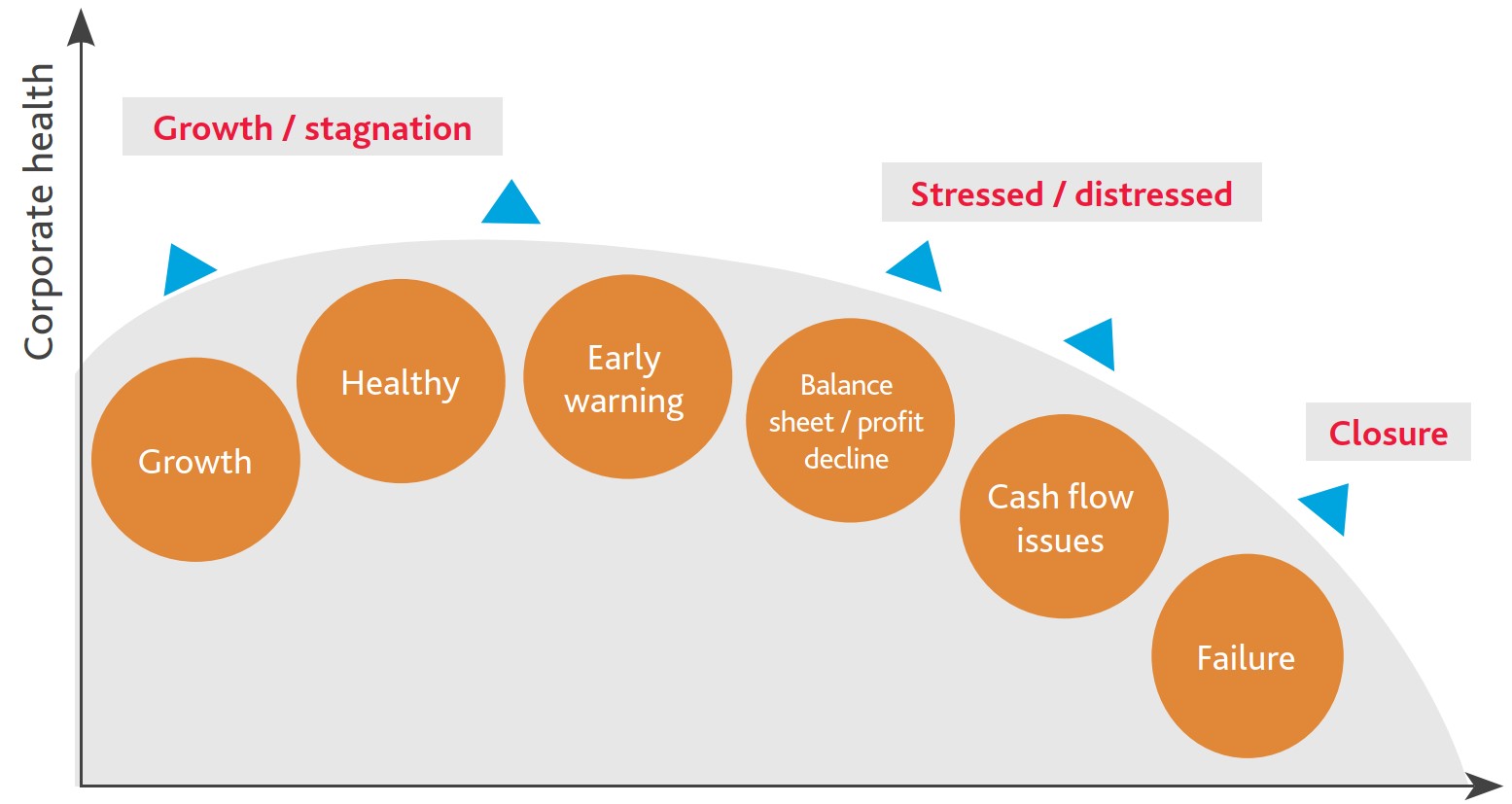February 2025
- Latest data shows 1 in 6 UK mid-market businesses are ‘at risk’ of being or becoming a ‘zombie’. This is a sharp increase of over 600 businesses (3.5 percentage points) in the last 12 months.
- Previous reports showed only modest year-on-year increases, but the mounting pressures from rising borrowing costs, high energy prices, unstable consumer sentiment, and inflation are now starting to show in our data.
- Real Estate Activities, Leisure & Hospitality and Mining & Quarrying are the sectors most vulnerable.
- Whilst the mid-market has been extremely resilient to turbulent geopolitical and economic headwinds, businesses with low profitability and high debt burdens need to address their resilience and take action.
- Working capital analysis shows that there is an average of over £10m of cash trapped in ‘at risk’ businesses that could be released and invested to reverse their decline.
Our tracker of over 20,000 companies, with a turnover between £10m and £500m, continues to assess the number of businesses within the UK mid-market that are ‘at risk’ of being or becoming zombies.
Mid-market businesses have long led the drive for growth as the engine of the UK’s economy. These businesses report revenues that are equivalent to more than half the value of UK GDP and they’re responsible for almost one in three private sector jobs.
Although the very worst of the pandemic aftermath has subsided, other problems are now impacting the UK’s resilient mid-market - stubborn interest rates and the lasting effect of significant inflationary spikes. Businesses of this size often also fall into a public policy gap – too large to benefit from policies tailored to small businesses, yet too small to command the same attention as FTSE firms.
This is beginning to show in the data, with a 3.5 percentage point (over 600 businesses) uptick versus the previous report. Businesses consistently tell us that issues related to growth funding, complex and uncertain tax policies and major skills shortages are all hampering this market. More is needed to support growth in this challenging environment.
The latest trends – what’s changed?
Previous trackers have shown modest increases, likely due to delayed financial reporting and government support packages during Covid. However, our latest analysis shows the data catching up with the difficult macroeconomic environment currently faced by the UK mid-market.
The latest tracker shows a significantly weakened position. We are beginning to see the effects of increased borrowing costs, high energy costs, unstable consumer sentiment and wider inflationary pressure.
A significant 15.9% of the UK mid-market are deemed to be ‘at risk’ of being a so-called zombie. This represents a sharp rise of 3.5 percentage points in 12 months, up from 12.4% in February 2024.
Although the worst effects of the pandemic have eased, the biggest impact zombie companies are now facing is the effect of increased interest rates. While they previously benefited from low borrowing costs that helped avoid significant financial distress, that advantage has disappeared.
The main issue for many of these companies is their limited cash reserves, coupled with the fact that much of their debt carries variable, rather than fixed, interest rates, making the impact of rising rates even more severe.
Recent Bank of England interest rate decreases will soften this, but rates are likely to remain stubborn and much higher than post-2008 levels.
As these challenges are compounded by significant cost increases and volatile customer demand, the operating environment for management teams becomes increasingly difficult.
Very few sectors have been able to buck this trend, and our data shows that all but two have had notable increases in the % of ‘at risk’ businesses.
Real Estate Activities, previously ranked fourth, has seen a sharp increase of 10.1%. This has caused the industry to become the most ‘at risk’ in the current tracker with 25.1% of businesses deemed to be ‘at risk’ zombies.
This is reflective of the UK real estate sector grappling with a combination of challenges in recent years. Rising interest rates have significantly increased borrowing costs for both buyers and developers, while the cost-of-living crisis has eroded affordability for many. Economic uncertainty, stemming from political instability, both at home and abroad, has dampened investor confidence.
Supply chain disruptions have driven up construction costs and exacerbated delays, while evolving consumer preferences and remote work trends have necessitated a reassessment of property development and investment strategies.
Leisure & Hospitality, previously the most ‘at risk’, drops one place to second, with 23.4% of businesses ‘at risk’. Despite the drop in rank, this sector has still seen an adverse movement of 1.1 percentage points from the previous tracker.
The cost-of-living crisis has continually impacted consumer spending, reducing discretionary income available for dining out, travel, and entertainment. This has been compounded by rising inflation, which has increased operational costs for businesses across the sector. Labour shortages exacerbated by Brexit, attempts to curb net migration, and changing employment patterns have created significant staffing challenges. This has impacted service quality and increased operational costs.
This sector is likely to be hit particularly hard by the forthcoming tax and wage increases (April 2025). In addition, continued consumer anxiety continues to impact demand and profitability in the wider sector.
Mining and Quarrying was the biggest riser and placed third, with the percentage of ‘at risk’ businesses in the sector increasing by 11.9% to 20.7%.
The causes of this decline in performance are likely due to several factors, including: rising costs - such as energy and input materials - putting pressure on profit margins; weakening global demand for raw materials, driven by a potential economic slowdown, which negatively impacts export -oriented mining operations; ongoing supply chain disruptions that hinder production and increase operational costs; stricter environmental regulations or permitting delays that hamper production and investment; and finally, increased competition from other mining regions, which may have put downward pressure on prices for UK-produced minerals.
Utilities remained the lowest sector ‘at risk’ with 10.8% of business deemed to be zombies. This is unsurprising as this sector has consistently ranked in the lowest three industries ‘at risk’ in previous iterations of this article.
Utilities businesses tend to resist economic volatility. Unlike other sectors, such as consumer discretionary industries, demand for utilities tends to be stable irrespective of how the economy is performing.
Energy producers have benefitted from increased prices, mostly related to reduced supply given the Ukraine / Russia conflict. Despite being the least ‘at risk’, this sector still experienced a 6.7% increase in ‘at risk’ businesses from the previous tracker.
This is indicative of the fact that even sectors which are more resistant to economic volatility have still experienced a more challenging operating environment in recent periods and should take the necessary action to shore up working capital and mitigate any risks which could lead to them becoming zombies.
What regions are most ‘at risk’?
Our graphic below looks at the proportion of ‘at risk’ businesses within each UK geographic region using registered office information.
Geographically, the concentration of ‘at risk’ businesses varies across the UK. Northern Ireland remains an outlier with a low ‘at risk’ percentage of 7.5%, albeit from a small sample size.
Greater London, North East and South East were the three highest ‘at risk’ regions.
Greater London has the highest concentration of ‘at risk’ businesses with 17.8%, previously 13.3% in February 2024. Across 12 of the 14 industries, the region has an above national-average percentage of ‘at risk’ businesses. Greater London data is likely skewed slightly by businesses having their registered office in the region but have core operations spread across the UK.
The percentage of ‘at risk’ businesses within this region in the Real Estate Activities and Health & Social Work Activities sectors are significantly higher than the national average. Real Estate Activities has an ‘at risk’ percentage of 34% (9% higher than the national average), whereas Health & Social Work Activities has an ‘at risk’ percentage of 32% (12.9% higher than the national average).
Leisure & Hospitality and Construction were also notably higher than the national average in Greater London, with 26.3% (3% higher) and 18.6% (4.4% higher) of these businesses deemed to be ‘at risk’ respectively.
Greater London's unique characteristics are exacerbated by the economic headwinds. Its already high costs of living have been further squeezed by inflation, impacting business’ margins and dampening consumer spending. Leisure & Hospitality, as well as other sectors, suffered from global economic slowdown and geopolitical events. The office market downturn, driven by remote work trends, negatively affected commercial real estate activities. Ongoing supply chain disruptions and persistent labour shortages add to operational difficulties. Brexit-related challenges, including increased trade barriers and regulatory hurdles, have affected businesses.
The North East ranked second with an ‘at risk’ percentage of 17.6%, previously 11.4%. This region experienced the largest rise in ‘at risk’ businesses, increasing by 6.3%. ‘At risk’ percentages in the North East were above average in 8 out of the 14 industries. Transport & Storage and Leisure & Hospitality were both significantly higher than the national average, scoring 37.5% and 36.6% respectively. However, both industries do have a limited sample size in this region which may skew the data slightly.
Bucking this trend, however, is Manufacturing in the North East which makes up largest proportion of businesses in the region included in our sample. These businesses had a slightly lower ‘at risk’ percentage compared to the national average with only 12.8% of businesses deemed to be ‘at risk’ versus the national average of 15.9%.
The North East of England has faced a particularly challenging operating environment in recent periods. The region's economy, historically reliant on more traditional industries, proved vulnerable to global economic shifts and declining demand. High unemployment rates and lower wages limited consumer spending, while geographic disadvantages hindered trade and investment. Moreover, skills shortages and the aforementioned continued reliance on declining industries further hampered growth and innovation in the region.
Business turnaround: what do ‘at risk’ firms need to do?
Whilst our analysis shows the number of firms ‘at risk’ may be lower than expected, there is still a significant minority that may not be well-positioned to enter choppy waters. Companies that are currently ‘at risk’ with low profitability and high debt burdens need to address their resilience and take action.
The strength of company balance sheets often depends on the level of funds shareholders have taken out as dividends, the amount of debt taken, or the amount invested in new products and assets. This will impact a company’s options and the time available to implement changes or turnaround actions.
It is likely that most ‘at risk’ businesses will have reluctantly moved further to the right on the corporate decline curve as a result of recent economic challenges – see chart below.

In general, businesses responded well to the impact of geopolitical tension, Covid-19 and Brexit. They focused on minimising the effects on business operations by reducing costs, preserving cash, seeking additional funds to plug short-term funding gaps.
However, most businesses will require more transformational action to ensure they can prime themselves to survive the coming economic turbulence. We highlight below some of the short-term actions that we have advised clients to implement. Addressing these issues now has been fundamental to a business’ longer-term health and protecting shareholder value.
In addition, the funding required to help deliver these actions could be readily - and cheaply - available to most businesses, trapped in their working capital. Analysis shows that the ‘at risk’ businesses in the tracker have up to £10m in cash tied up in inefficient working capital processes, unpaid invoices and stock.
The restructuring provisions within the Corporate Insolvency and Governance Act 2020 (‘CIGA’) were a welcome addition to the suite of restructuring tools, especially as these are debtor-led, allowing the company to control the restructuring process. These new tools grant businesses a level of moratorium protection as they navigate their way out of the current environment. However, the use of these protections requires early intervention to allow time to create a viable financial and operational restructuring plan.
Although the current economic environment is having a significant impact on the mid-market, we would suggest that companies should respond positively to the challenges and use instability as a catalyst for change, and an opportunity to build resilience into their operations. Many of our clients have already embarked on this journey and are actively in the process of reshaping their businesses.
To understand how your business can build its resilience, or to discuss the data further, please contact Ross McWhir or Ben Peterson.


